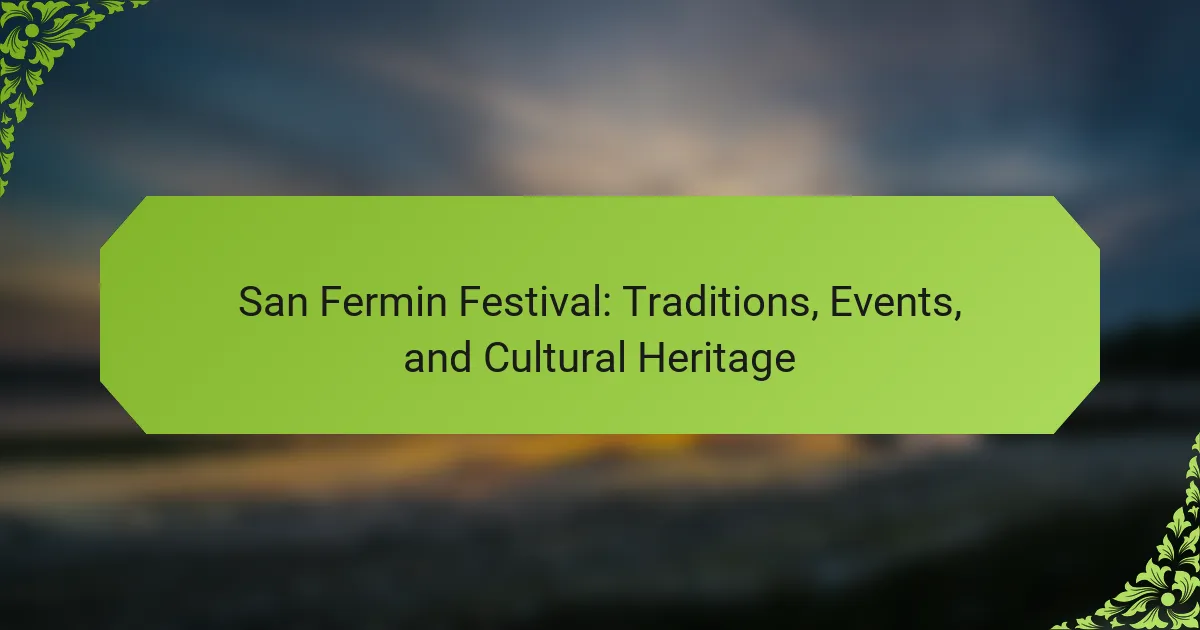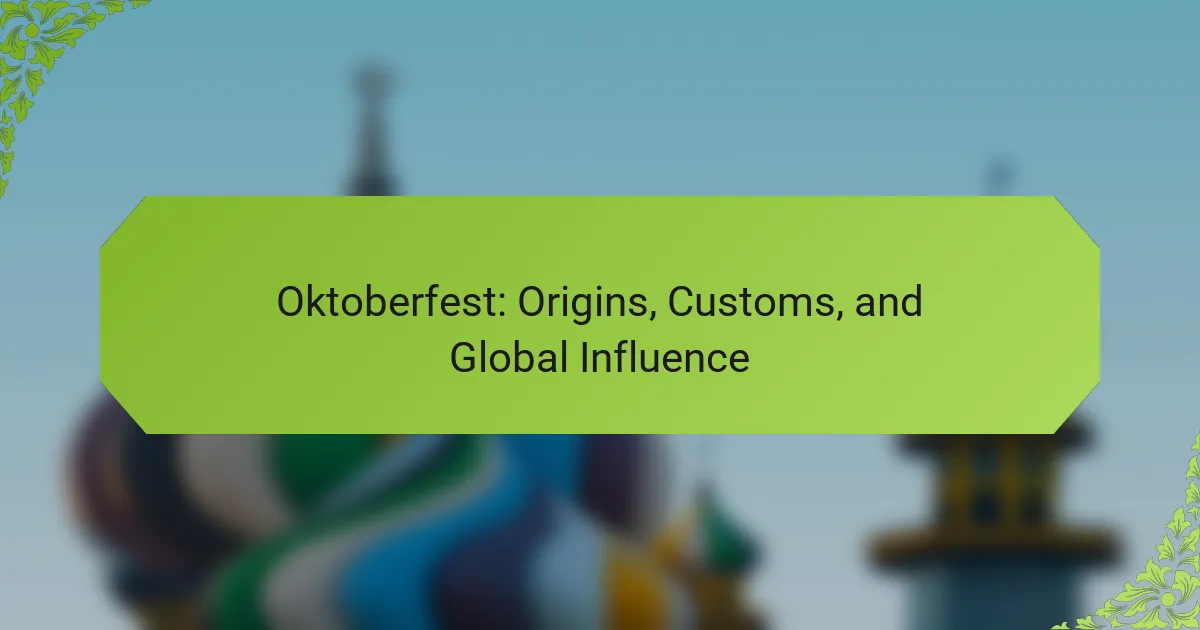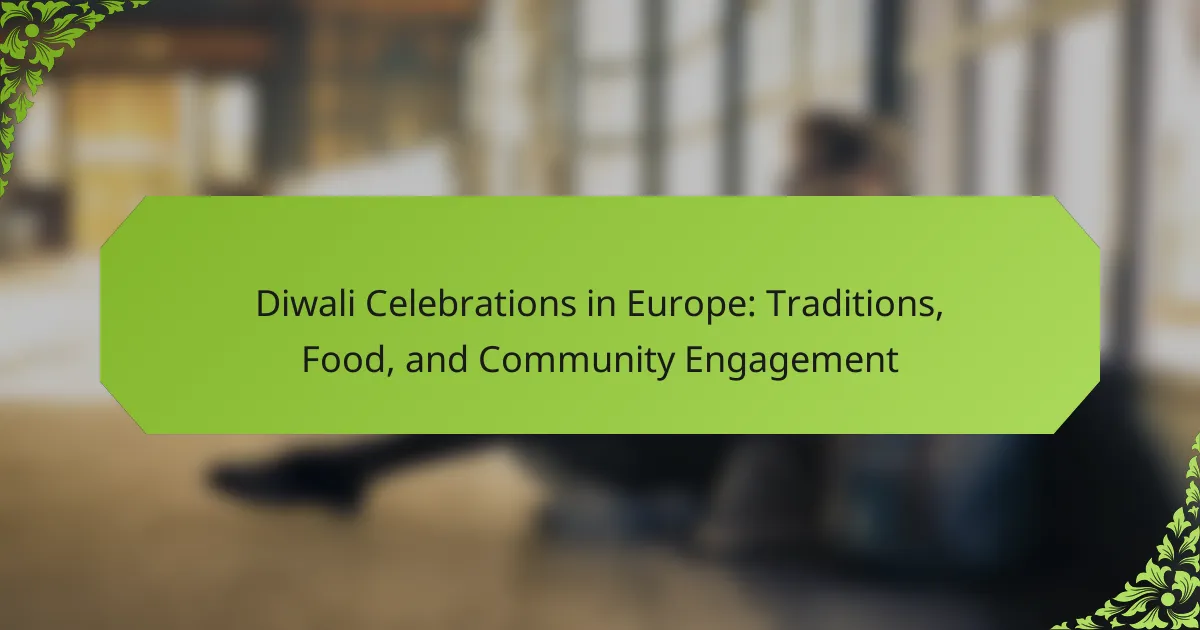The San Fermin Festival is a vibrant celebration that showcases the cultural heritage of Pamplona through its key traditions and events. Highlights include the thrilling Running of the Bulls, the festive Chupinazo opening ceremony, and daily parades honoring Saint Fermin. This article explores the festival’s rich history, evolving traditions, and essential safety measures, providing insights into its significance as a global cultural phenomenon.
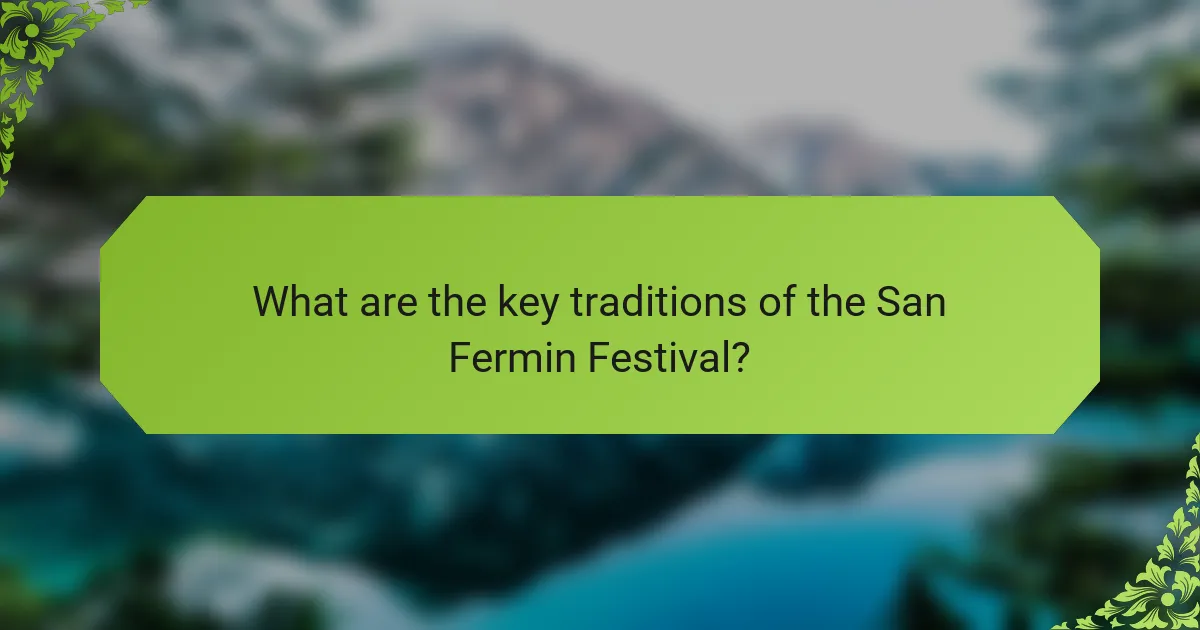
What are the key traditions of the San Fermin Festival?
The key traditions of the San Fermin Festival include the Running of the Bulls, daily morning encierros, traditional music, and the Chupinazo opening ceremony. These events showcase the festival’s cultural heritage and attract thousands of participants and spectators each year. The Running of the Bulls, a unique and thrilling event, involves bulls running through the streets of Pamplona, emphasizing bravery and tradition. The Chupinazo, a rocket launch that marks the festival’s start, is celebrated with enthusiasm. Traditional attire, including the white outfit with a red scarf, symbolizes unity among festival-goers.
How do local customs influence festival practices?
Local customs significantly shape the San Fermin Festival’s practices, emphasizing community participation and cultural identity. Each year, local traditions influence the festival’s events, such as the iconic running of the bulls, which reflects regional pride and historical significance.
The festival includes unique rituals, like the daily morning encierro, where locals engage in a centuries-old tradition of running alongside the bulls. These customs foster a sense of belonging and continuity among participants.
Additionally, local gastronomy plays a vital role, with traditional foods like pintxos and local wines enhancing the festival experience. These culinary practices highlight the region’s agricultural heritage and contribute to the festival’s festive atmosphere.
Overall, the San Fermin Festival exemplifies how local customs not only preserve cultural heritage but also enhance community cohesion during this vibrant celebration.
What role do religious observances play in the festival?
Religious observances are central to the San Fermin Festival, emphasizing community and tradition. The festival includes daily masses and processions honoring Saint Fermin, the patron saint of Pamplona. These rituals foster a sense of unity among participants and reflect the cultural heritage of the region. Additionally, the blending of religious practices with festive activities highlights the unique attributes of this celebration, making it a profound spiritual and social event.
Which traditional foods are integral to the celebration?
Traditional foods integral to the San Fermin Festival include pintxos, churros, and the famous regional dish, paella. These foods reflect the local culinary heritage and enhance the festive atmosphere. Pintxos, small snacks typically served on skewers, are popular among attendees. Churros, often enjoyed with hot chocolate, provide a sweet treat during the celebrations. Paella, a rice dish with various ingredients, showcases the rich flavors of the region. Each dish contributes to the vibrant experience of the festival.

What events are central to the San Fermin Festival?
The San Fermin Festival features several central events, including the famous running of the bulls, traditional parades, and religious ceremonies. The festival begins with the “chupinazo,” a rocket launch that marks the start of the festivities. Each day includes bull runs, where participants run in front of the bulls through the streets of Pamplona. Additionally, there are daily processions honoring Saint Fermin, live music, and various cultural performances that highlight the region’s heritage. The festival culminates with a grand fireworks display, celebrating the vibrant spirit of the event.
How does the running of the bulls shape the festival experience?
The running of the bulls is central to the San Fermin Festival, enhancing excitement and cultural significance. This event draws thousands of participants and spectators, creating a unique atmosphere of adrenaline and tradition. The spectacle fosters community engagement and attracts global attention, reinforcing the festival’s identity. Additionally, the event embodies bravery and cultural pride, contributing to the festival’s deep-rooted heritage.
What are the highlights of the daily parades and performances?
The daily parades and performances at the San Fermin Festival are vibrant and culturally rich events. Highlights include the opening ceremony, traditional music, and the famous running of the bulls. Each parade showcases colorful costumes, energetic dancers, and local folklore, creating an immersive experience. The performances often feature regional bands and dance groups, celebrating Navarra’s unique heritage. The atmosphere is festive, drawing locals and tourists alike, making it a memorable part of the festival.
Which events are unique to specific regions or communities?
The San Fermin Festival features unique events specific to Pamplona, Spain. Key events include the Running of the Bulls, traditional music, and local culinary offerings. The festival’s cultural heritage is deeply rooted in regional customs, making it a distinct celebration. Each event showcases the community’s spirit and traditions, attracting visitors worldwide.
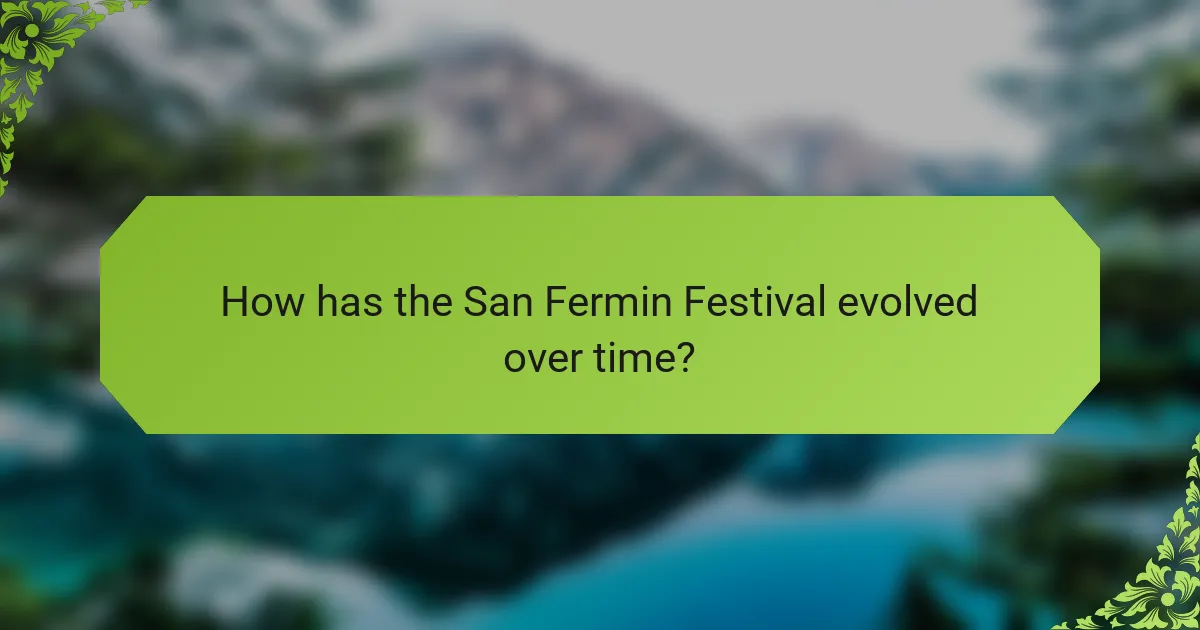
How has the San Fermin Festival evolved over time?
The San Fermin Festival has evolved significantly since its inception in the 13th century. Originally a religious event honoring Saint Fermin, it has transformed into a vibrant cultural celebration. The festival now features iconic events such as the running of the bulls, parades, and traditional music.
In recent years, the festival has incorporated modern elements while preserving its historical roots. For example, the inclusion of international artists and contemporary performances showcases its adaptability. The festival attracts millions of visitors, enhancing its status as a global cultural phenomenon.
Additionally, local customs and rituals continue to play a vital role, ensuring that the festival remains a unique expression of Pamplona’s cultural heritage. The blend of tradition and modernity contributes to its ongoing popularity and relevance.
What historical influences have shaped current practices?
The San Fermin Festival has been shaped by historical influences such as regional customs, religious practices, and agricultural traditions. Originating in the medieval period, the festival combines elements of devotion to Saint Fermin, local celebrations, and the running of the bulls, reflecting the community’s agricultural heritage. Over time, these practices have evolved, integrating modern festivities while preserving unique attributes like traditional attire and music. The festival’s cultural significance is evident in its global recognition and the preservation of local customs.
How do modern adaptations reflect changing cultural values?
Modern adaptations of the San Fermin Festival reflect evolving cultural values by emphasizing inclusivity and sustainability. As society becomes more aware of social issues, the festival has incorporated diverse cultural expressions and reduced its environmental impact.
For example, traditional events now include performances from various cultural groups, showcasing a broader representation of local heritage. Additionally, the festival has adopted eco-friendly practices, such as waste reduction initiatives, aligning with global sustainability trends.
These changes highlight a shift towards community engagement and environmental stewardship, demonstrating how cultural heritage can adapt to contemporary values while preserving its core identity.
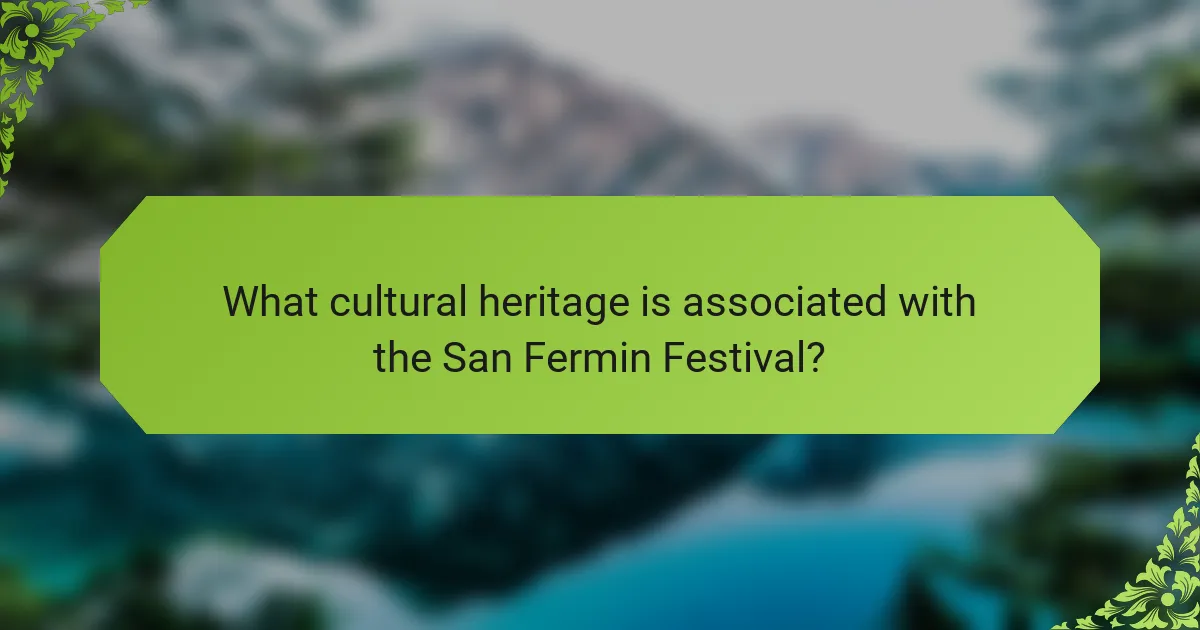
What cultural heritage is associated with the San Fermin Festival?
The San Fermin Festival is deeply rooted in Basque culture, showcasing traditions like traditional dress, music, and dance. Key events include the famous Running of the Bulls and religious processions honoring Saint Fermin. These elements reflect the festival’s unique attributes, emphasizing community spirit and cultural pride. The festival attracts global attention, reinforcing its status as a significant cultural heritage event.
How does the festival contribute to local identity and pride?
The San Fermin Festival enhances local identity and pride through its rich traditions and communal participation. This festival fosters a sense of belonging among residents, as they engage in various events that celebrate their cultural heritage. The iconic running of the bulls symbolizes bravery and unity, reinforcing community ties. Additionally, local cuisine and music showcased during the festival highlight regional uniqueness, further instilling pride in local customs. The festival attracts visitors, promoting cultural exchange and boosting the local economy, which strengthens community identity.
What role do arts and music play in the festival’s cultural expression?
Arts and music are vital to the San Fermin Festival’s cultural expression, showcasing regional identity and communal spirit. Traditional music, such as folk songs, enhances the festival’s atmosphere, while artistic displays reflect local heritage. The incorporation of dance and visual arts fosters community engagement and celebrates cultural diversity. Together, these elements create an immersive experience that honors tradition and invites participation.
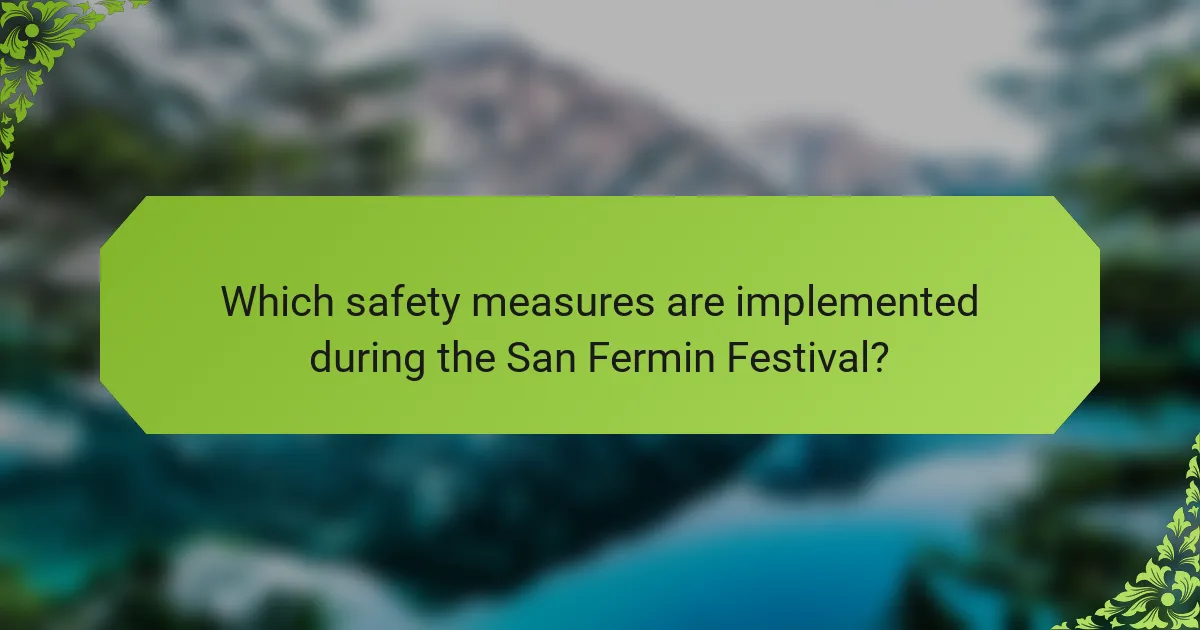
Which safety measures are implemented during the San Fermin Festival?
The San Fermin Festival implements various safety measures to ensure participant well-being. Key safety protocols include crowd control, designated emergency services, and risk assessments for events.
1. Crowd management strategies are employed to prevent overcrowding.
2. Emergency medical teams are stationed throughout the festival area.
3. Clear signage indicates safe routes and emergency exits.
4. Alcohol consumption is monitored to reduce risks.
5. Safety briefings are conducted for participants in events like the running of the bulls.
6. Surveillance systems enhance monitoring of large gatherings.
How do organizers ensure participant safety during events?
Organizers ensure participant safety during the San Fermin Festival by implementing strict crowd control measures and emergency protocols. They establish designated safe zones and employ trained personnel to monitor activities. Regular safety briefings and clear communication of rules help participants understand risks. Additionally, medical teams are on standby to address any emergencies swiftly.
What are common safety challenges faced by attendees?
Attendees at the San Fermin Festival face several common safety challenges. The most significant issues include overcrowding, which can lead to trampling, and the risk of injuries from the running of the bulls. Additionally, alcohol consumption often escalates risky behaviors and can result in accidents. Public disturbances and inadequate emergency response resources further complicate safety efforts. Lastly, the festival’s chaotic environment can make it difficult for attendees to access medical assistance when needed.

What is the global perception of the San Fermin Festival?
The global perception of the San Fermin Festival is largely positive, celebrated for its vibrant traditions and cultural significance. Many view it as an exhilarating experience that combines religious devotion, community spirit, and thrilling events. The festival’s iconic running of the bulls attracts thousands of tourists, enhancing its reputation as a unique cultural event. However, some criticism arises from concerns about animal welfare, leading to ongoing debates about its practices. Despite this, the festival remains a symbol of Spanish heritage, drawing attention for its lively atmosphere and historical roots.
How do international visitors experience the festival differently?
International visitors experience the San Fermin Festival with unique perspectives shaped by cultural differences. They often engage more deeply with traditional events, such as the encierro, or running of the bulls, viewing them as thrilling spectacles rather than local customs.
Many visitors partake in local traditions like txupinazo, the opening ceremony, which may differ from their cultural celebrations. The festival’s vibrant atmosphere attracts tourists seeking authentic experiences, leading to a blend of local and global interactions.
Additionally, international attendees may have varied interpretations of the festival’s significance, influenced by their backgrounds. They often share their experiences through social media, amplifying the festival’s reach and creating a global community around this cultural heritage.
What impact does media coverage have on the festival’s reputation?
Media coverage significantly enhances the San Fermin Festival’s reputation by attracting global attention and participation. Positive media portrayals highlight the festival’s unique cultural heritage and traditions, increasing its appeal. Coverage of events like the running of the bulls and traditional music fosters excitement and curiosity among potential attendees. Additionally, social media amplifies these narratives, allowing for real-time engagement and sharing of experiences. As a result, the festival’s visibility and perceived value in cultural tourism grow, benefiting local businesses and the community.

What are best practices for enjoying the San Fermin Festival?
To enjoy the San Fermin Festival, engage with its vibrant traditions and events. Arrive early to secure a good viewing spot for the iconic running of the bulls. Participate in local customs, such as wearing traditional white attire with a red scarf. Attend the daily schedule of events, including parades and fireworks, to fully experience the festival’s cultural heritage. Stay hydrated and maintain awareness of your surroundings for safety during the festivities.
How can attendees prepare for a safe and enjoyable experience?
Attendees can prepare for a safe and enjoyable experience at the San Fermin Festival by following essential guidelines. First, familiarize yourself with the schedule of events and traditions to fully engage in the festivities. Wear appropriate clothing, including comfortable shoes, as many activities involve walking or running. Hydration is crucial, so drink plenty of water, especially during the hot summer days.
Plan your accommodations in advance, as hotels fill quickly. Stay informed about local customs and safety measures, particularly regarding the running of the bulls. Lastly, consider traveling with a group for added safety and shared experiences.
What common mistakes should festival-goers avoid?
Festival-goers should avoid overindulgence, neglecting safety, and ignoring local customs. Staying hydrated and being aware of surroundings enhances the experience. Respecting traditions, such as the running of the bulls, is essential for cultural appreciation. Plan ahead to manage crowds and transportation effectively.
